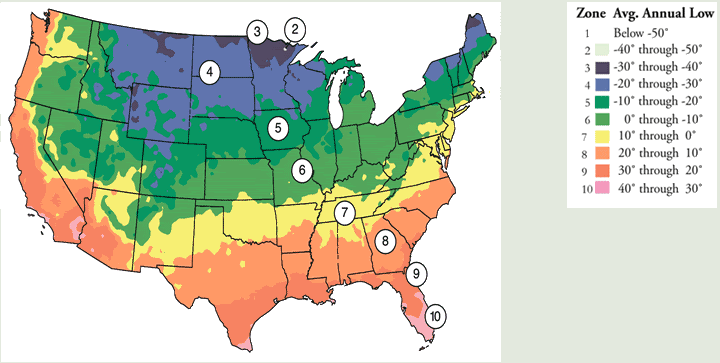
Whether a plant can survive the winter isn’t your only concern. You know annuals are going to live for only one season, but you also want to know how long that season will be. After all, you may not be pleased if your dahlias die before flowering or your tomato plants freeze before producing much fruit. Unfortunately, hardiness zones don’t tell you much about the length of the growing season. Enter the frost zone map.
Zones are determined not only by temperatures but also by the climate, which combines temperature readings, rainfall, humidity, wind, air pressure, and other factors. Climates in frost zone maps are generally determined by growing season, the time during which — hold onto your hats — plants add new growth. The last spring frost and the first fall frost bookend the growing season, marking a nice period of frost-free days. Basically, this time period is your window of opportunity to plant and nurture and enjoy your home landscape, whether you’re growing flowers or edibles. Make the most of it! In really mild areas, such as parts of Southern California, Florida, and the Gulf Coast, the entire year is likely to be frost-free and wide open. The rest of us may feel we’re not as lucky (but just remember that those folks, and their plants, have to contend with intense summer heat and humidity, not to mention bugs that are never killed by frost).
Look at it this way: If you have a colder winter, you get a break, a chance to stop and relax — and a chance regroup and plan for an even better garden next year, after the last frost is past. The length of a growing season varies somewhat from year to year but is generally about the same. You probably already have a sense of your growing season, but if you really need to know, finding out is fairly easy. Call your nearest Cooperative Extension Service office, ask a knowledgeable gardener or garden-center staffer, or watch your local newspaper for the frost dates (which can vary from one year to the next). Many gardeners also use frost zone maps, like the one here: www.avant-gardening.com/zone. Here’s how to calculate your growing season: Suppose you live in Denver, Colorado; your last frost is May 3, and your first fall freeze is October 8. That gives you 157 days in which to garden. Or suppose you live in Las Vegas, Nevada; your last frost is March 7, and your first fall one is November 21. You get 259 days of growing.
Winter doesn’t mean a gardener can or should be idle in the downtime. You can find plenty to do if you’re so inclined to capitalize on the “shoulder seasons.” You can be plotting for the future, starting seeds indoors with the plan to put them out in the ground the minute the last spring frost passes; you can be reading and discovering more about plants; you can be fussing with cleaning and sharpening your tools; you can enjoy yourself as you care for indoor plants; and you can be placing orders with mail-order suppliers —all activities that feed into the process and joy of having a wonderful garden.
Zones are determined not only by temperatures but also by the climate, which combines temperature readings, rainfall, humidity, wind, air pressure, and other factors. Climates in frost zone maps are generally determined by growing season, the time during which — hold onto your hats — plants add new growth. The last spring frost and the first fall frost bookend the growing season, marking a nice period of frost-free days. Basically, this time period is your window of opportunity to plant and nurture and enjoy your home landscape, whether you’re growing flowers or edibles. Make the most of it! In really mild areas, such as parts of Southern California, Florida, and the Gulf Coast, the entire year is likely to be frost-free and wide open. The rest of us may feel we’re not as lucky (but just remember that those folks, and their plants, have to contend with intense summer heat and humidity, not to mention bugs that are never killed by frost).
Look at it this way: If you have a colder winter, you get a break, a chance to stop and relax — and a chance regroup and plan for an even better garden next year, after the last frost is past. The length of a growing season varies somewhat from year to year but is generally about the same. You probably already have a sense of your growing season, but if you really need to know, finding out is fairly easy. Call your nearest Cooperative Extension Service office, ask a knowledgeable gardener or garden-center staffer, or watch your local newspaper for the frost dates (which can vary from one year to the next). Many gardeners also use frost zone maps, like the one here: www.avant-gardening.com/zone. Here’s how to calculate your growing season: Suppose you live in Denver, Colorado; your last frost is May 3, and your first fall freeze is October 8. That gives you 157 days in which to garden. Or suppose you live in Las Vegas, Nevada; your last frost is March 7, and your first fall one is November 21. You get 259 days of growing.
Winter doesn’t mean a gardener can or should be idle in the downtime. You can find plenty to do if you’re so inclined to capitalize on the “shoulder seasons.” You can be plotting for the future, starting seeds indoors with the plan to put them out in the ground the minute the last spring frost passes; you can be reading and discovering more about plants; you can be fussing with cleaning and sharpening your tools; you can enjoy yourself as you care for indoor plants; and you can be placing orders with mail-order suppliers —all activities that feed into the process and joy of having a wonderful garden.

No comments:
Post a Comment